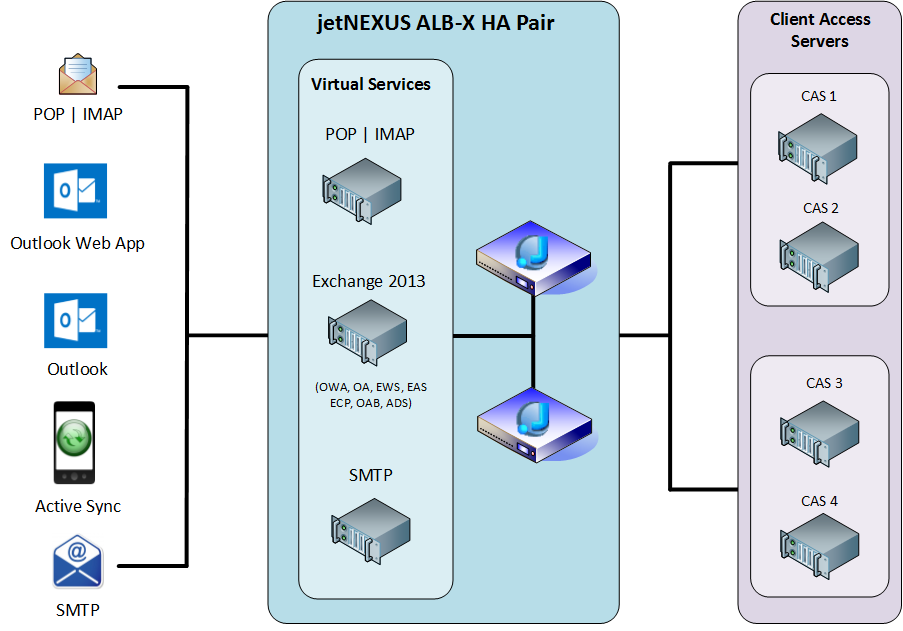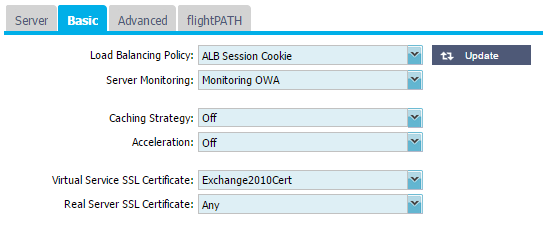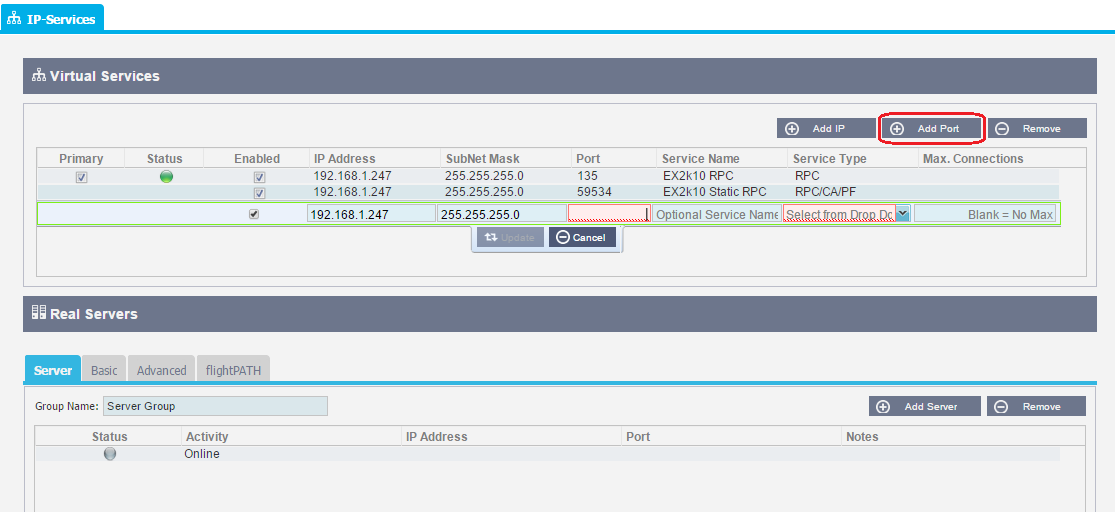jetNEXUS ALB-X Exchange 2010 Deployment Guide
- Synopsis
- Pre-Requisites
- Overview
- Why jetNEXUS?
- What is a jetPACK?
- Exchange 2010 Description
- Standard Exchange Diagram
- Modifying Exchange 2010
- jetNEXUS ALB-X Configuration
- Adding a virtual service
- Add another virtual service to an existing service
- Adding a Real Server
- Configuring RPC (End Point Mapper)
- Configuring Static RPC/CA/PF (Client Access/Public Folders)
- Configuring Static RPC/ADS (Address Book Service)
- Configuring HTTPS OWA – Layer 7
- Configuring HTTPS OWA – Layer 4
- Real Server Monitor
- SSL Certificates
- TCP Timeout Changes
- jetPACK Quick Installation
- Troubleshooting
- Contact Us
Synopsis
This document explains briefly the concept of Exchange 2010 and how to use an ALB-X to load balance Exchange 2010 Traffic.
Pre-requisites
The following are general prerequisites and configuration notes for this guide:
- It is assumed that the reader is a network administrator or person familiar with networking and general computer terminology
- You have set-up your Microsoft Exchange 2010 environment and have installed your jetNEXUS ALB-X application delivery controller
- When Microsoft refer to a hardware load balancer (HLB) it is equivalent to the industry term “Application Delivery Controller”
- You are running Software Version 4.0.1 (Build 1576) or later on your jetNEXUS ALB-X
Overview
The ALB-X is an Application Delivery Controller (ADC) sometimes referred to as a next generation load balancer.
This document assumes that you are already familiar with using the ALB-X interface.
This document assumes that you are already familiar with the process of installing Exchange, creating a DAG, and creating a CAS Array.
Why jetNEXUS?
|
Application layer server health checks, detect and route around problems to eliminate downtime |
|
Speedy layer 4 load balancing with layer 7 health checks ensure the most efficient load balancing is achieved |
|
Traffic from external clients is securely proxied by edgeNEXUS ensuring no external client can directly access internal resource |
|
The CAS array in Exchange 2010 requires session persistence. jetNEXUS ALB-X provides IP and Cookie based session persistence |
|
Compression is automatically used to accelerate external web and mobile clients |
|
Enables end to end secure encrypted traffic between client and internal resources whilst still being able to provide acceleration and traffic manipulation with flightPATH |
|
Our intelligent application layer traffic manipulation engine can be easily configured to redirect OWA clients to the correct service |
What is a jetPACK?
A jetPACK is a simple text file that you can upload to your appliance that contains all of the configuration needed to deploy an application such as Exchange 2013.
For more information on jetPACK – Click Here
Exchange 2010 description
Brief overview of Exchange 2010 load balancing configuration is provided below:
Outlook Clients
The Outlook clients we have used during testing are made up of Outlook 2003, Outlook 2007 & Outlook 2010 which send their requests to the CAS.
Client Access Server (CAS) Role
The Client Access Server (CAS) role accepts connections from a variety of clients to allow them access to the Exchange Server infrastructure.
Database Availability Group (DAG)
The Database Availability Group (DAG) is made up of Exchange Server 2010 Mailbox servers that provide automatic database-level recovery from a database, server, or network failure.
Standard Exchange 2010 Diagram

Modifying Exchange 2010 Client Access Servers
To enable load balancing on Exchange 2010 we will need to make some changes to each of the servers within CAS Array. We need to set static ports for RPC Client Access service, Address Book service and Public folders.
By default they use a dynamic RPC port range (6005-59530) for outgoing connections.
Microsoft recommends you set the RPC Client Access Service and Public Folders to a unique value between 59531 and 60554. We have used 59534 in our example.
Microsoft recommends you set the RPC Address Book Service to a unique value between 59531 and 60554. We have used 59535 in our example.
Please click on the following link for instructions:
How to configure Static RPC Ports on an Exchange 2010 Client Access Server
jetNEXUS ALB-X Configuration
Example of Completed Rule
Below you will see the completed set of services.
| Virtual IP address | 192.168.1.247 | The address that Outlook clients should resolve the FQDN to |
| Virtual Service for MAPI clients | 135, 59534, 59535 | Static RPC ports needs for Outlook clients |
| Virtual Service for Outlook Web App | 443 | Secure Outlook Web App port |
| Virtual Service for Redirect | 80 | Used to redirect clients to from http to https and add in the correct /owa path |
| Client Access Server 1 | 192.168.1.215 | Real server address of CAS 1 |
| Client Access Server 2 | 192.168.1.216 | Real server address of CAS 2 |
Adding a Virtual Service
The IP Service configuration screen is the main configuration screen for load balancing functionality and it can be found in (Setup – IP Services).
- 1.Click Add IP. This will add a new blank row with the cursor focus in the IP address Column
- 2.Enter the Virtual Service IP Address and tab to each column in turn
- 3.Click Update once all available columns have been completed
- 4.The cursor focus will then move to the IP address column for the Real Server configuration
Adding a Real Server
The Client Access Server details are configured in the bottom section of the page called “Real Servers“
- In the IP Address column enter the IP Address of your first Client Access Server.
- Tab to the Port column and enter in the port number for your service
- Tab to the Notes section and add in the name of the Client Access Server.
- Click Update, to save the configuration
Click Add Server, to configure additional Real Server details

Adding another Service to the Same Virtual IP
To set up another service on the same IP Address click “Add Port“
This time you do not need to specify the Virtual IP address or Subnet Mask as it has already been populated.
This now allows you to set up the new ports to each of the content CAS servers.
Configuring RPC
Configure the new virtual service with the IP details for your new service.
In this example we will configure the following IP details, based on a One-Armed Configuration.
Virtual Service Details:
| Primary: | n/a |
| IP Address: | 192.168.1.247 |
| Subnet Mask: | 255.255.255.0 |
| Port: | 135 |
| Service Name: | Exchange 2010 RPC |
| Service Type: | Layer4 |
| Max Connection: | n/a |
Destination:
| Real Server Details: | Exchange 2010 Client Access Server 1 |
| Real Server IP: | 192.168.1.215 |
| Real Server Port: | 135 |
Actions:
| Server Monitoring: | TCP Connection |
| Load Balancing Policy | IP-Bound (Formerly “IP Based”) |
| Connectivity: | Reverse Proxy (Formerly “Managed”) |
| Cache: | Off |
| Virtual Service SSL: | No SSL |
| Real Server SSL: | No SSL |
| Enable Connection Pooling: | N/A |
| Connection Pool Size: | N/A |
Configuring Static RPC/CA/PF (Client Access Service & Public Folders)
Configure the new virtual service with the IP details for your new service.
In this example we will configure the following IP details, based on a One-Armed Configuration.
Virtual Service Details:
| Primary: | n/a |
| IP Address: | 192.168.1.247 |
| Subnet Mask: | 255.255.255.0 |
| Port: | 59534 |
| Service Name: | Exchange 2010 RPC/CA/PF |
| Service Type: | Layer4 |
| Max Connection: | n/a |
Destination:
| Real Server Details: | Exchange 2010 Client Access Server 1 |
| Real Server IP: | 192.168.1.215 |
| Real Server Port: | 59534 |
| Notes | Client Access Server 1 |
Actions:
| Server Monitoring: | TCP Connection |
| Load Balancing Policy | IP-Bound (Formerly “IP Based”) |
| Connectivity: | Reverse Proxy (Formerly “Managed”) |
| Cache: | Off |
| Virtual Service SSL: | No SSL |
| Real Server SSL: | No SSL |
| Enable Connection Pooling: | N/A |
| Connection Pool Size: | N/A |
Configuring Static RPC/ADS (Address Book Service)
Configure the new virtual service with the IP details for your new service.
In this example we will configure the following IP details, based on a One-Armed Configuration.
Virtual Service Details:
| Primary: | n/a |
| IP Address: | 192.168.1.247 |
| Subnet Mask: | 255.255.255.0 |
| Port: | 59535 |
| Service Name: | Exchange 2010 RPC/ADS |
| Service Type: | Layer4 |
| Max Connection: | n/a |
Destination:
| Real Server Details: | Exchange 2010 Client Access Server 1 |
| Real Server IP: | 192.168.1.215 |
| Real Server Port: | 59535 |
Actions:
| Server Monitoring: | TCP Connection |
| Load Balancing Policy | IP-Bound (Formerly “IP Based”) |
| Connectivity: | Reverse Proxy (Formerly “Managed”) |
| Cache: | Off |
| Virtual Service SSL: | No SSL |
| Real Server SSL: | No SSL |
| Enable Connection Pooling: | N/A |
| Connection Pool Size: | N/A |
Configuring Exchange HTTPS (OWA) – Layer 7
Virtual Service Details:
| Primary: | n/a |
| IP Address: | 192.168.1.247 |
| Subnet Mask: | 255.255.255.0 |
| Port: | 443 |
| Service Name: | Exchange 2010 HTTPS |
| Service Type: | Accelerate HTTP |
| Max Connection: | n/a |
Destination:
| Real Server Details: | Exchange 2010 Client Access Server 1 |
| Real Server IP: | 192.168.1.215 |
| Real Server Port: | 443 |
Actions:
| Server Monitoring: | Monitoring OWA |
| Load Balancing Policy | Cookie |
| Connectivity: | Reverse Proxy (Formerly “Managed”) |
| Cache: | Off |
| Virtual Service SSL: | Exchange2010Certificate |
| Real Server SSL: | Any |
| Enable Connection Pooling: | N/A |
| Connection Pool Size: | N/A |
Configuring Exchange HTTPS (OWA) – Layer 4
Virtual Service Details:
| Primary: | n/a |
| IP Address: | 192.168.1.247 |
| Subnet Mask: | 255.255.255.0 |
| Port: | 443 |
| Service Name: | Exchange 2010 HTTPS |
| Service Type: | Accelerate HTTP |
| Max Connection: | n/a |
Destination:
| Real Server Details: | Exchange 2010 Client Access Server 1 |
| Real Server IP: | 192.168.1.215 |
| Real Server Port: | 443 |
Actions:
| Server Monitoring: | TCP Connection |
| Load Balancing Policy | Cookie |
| Connectivity: | Reverse Proxy (Formerly “Managed”) |
| Cache: | Off |
| Virtual Service SSL: | No SSL |
| Real Server SSL: | No SSL |
| Enable Connection Pooling: | N/A |
| Connection Pool Size: | N/A |
Real Server Monitor
For Exchange 2010 HTTPS OWA service you can create a Layer 7 application layer health check to ensure a server is capable of serving content.
Navigate to the Configure – Real-Server Monitor section.
- 1.Click Add Monitor
- 2.A new blank row will be created
- 3.Double Click on the Name column to edit then tab to each subsequent column and complete as below
- 4.This rule name will now appear in the Basic actions – Server Monitoring which you can select to apply to the 443 virtual service.
SSL Certificates
If you have chosen the option to configure OWA as a layer 7 service you will need to create or import a certificate in to the ALB-X.
Once you have either imported an existing certificate or created it on the jetNEXUS ALB-X you will then be able to select it from the SSL drop down within the Basic actions section.
Please refer to the userguide for more information how to manage SSL certificates.

TCP Timeout Changes
By default the jetNEXUS ALB-X has a 90 second timeout for TCP connections. Whilst this is very efficient for web traffic it is more desirable to extend this for Exchange 2010 deployment.
Please email support@edgenexus.io with your preferred TCP timeout value.
Values between 5 Minutes and 2 hours are recommended but we can customise this to any value you require.
support@edgenexus.io will send you a custom configuration update file which you then upload on to the ALB-X. This is a very quick and simple procedure that can be completed from within the GUI in around 15 seconds.
You can download a 2 hour TCP timeout jetPACK update here
To apply the jetPACK update
- 1.Navigate to Advanced – Update Software – Configuration
- 2.Click Browse (for the file above)
- 3.Click Upload and wait for approximately 15s
- 4.When the screen returns the TCP update has been applied
jetPACK Quick Installation
- The jetNEXUS ALB-X can be configured automatically with a Exchange 2010 “jetPACK”, template which is fully-tuned with all of the application-specific settings that you need in order to enjoy optimised service delivery from your ALB-X
- If you supply the virtual IP address and real server IP addresses to support@edgenexus.io we will send you a custom jetPACK that you simply upload to the jetNEXUS ALB-X
- The upload can be done via the GUI and will be fully configured in less than 1 minute
- The relevant jetPACK can be applied to multiple jetNEXUS ALB-X appliances saving valuable time and eliminating simple mistakes
- For more information and to download a jetPACK please click here
Troubleshooting
Further help can be found on the main edgeNEXUS website
Contact Us
I hope you have found this Deployment Guide informative, but if you need any clarification or further information, please do not hesitate to get in contact with edgeNEXUS Support:
| support@jetNEXUS.com | |
| Phone | +44 (0870) 382 5529 |
| Blog | http://jetNEXUS.blogspot.com/ |


